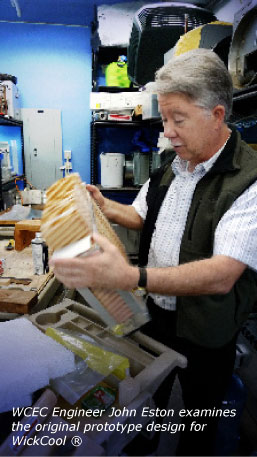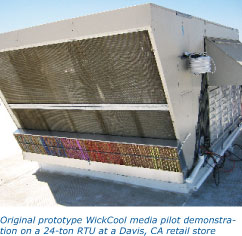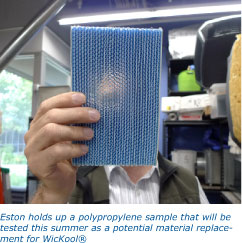 June 6th, 2011
June 6th, 2011
Energy efficiency is a balancing act between simplicity versus complexity, cost versus savings. In the HVAC industry many of the more energy efficient solutions can seem prohibitively complex, not to mention the wide array of choices can be downright daunting. Do you choose a variable-speed indirect evaporative cooler, or maybe an evaporative pre-cooler retrofit—will a building owner save money through energy savings and rebates? What about the added costs of training facilities managers to be able to actually service these newer systems? Is there an option out there that will save energy and money without the need for someone with an engineering degree to install and maintain? The WCEC feels they may have an elegant solution that reduces energy, works passively and is a cost effective retrofit to conventional rooftop units (RTUs) for hot and dry, Western climates.
One RTUs Waste is another RTUs Treasure
“The technology uses an existing by-product of standard HVAC systems, the condensate off the evaporator, to passively pre-cool the supply air” explains John Eston, an engineer working on testing this technology with the Western Cooling Efficiency Center.
This technology, originally developed by Richard Bourne of the Western Cooling Efficiency Center in 2009 and licensed to Octus Energy, pipes this condensate to a trough where it is soaked up by a special wicking evaporative media called WicKool® then evaporated to pre-cool the condenser air.
“Unlike conventional evaporative pre-coolers that use pumps to flow the water over an evaporative media, WicKool® is entirely passive, relying solely on the special media to wick the available condensate water vertically,” says Eston.
The solution is elegant because it does not require any additional machinery and consumes no electricity. The device eliminates the need and cost of condensate piping or circulation pumps while alleviating some of the electrical demand on the vapor compression system.
A Simple Solution Leads to Modest Energy Savings
This technology has the potential to save between 2% and 6% of the energy used on a conventional RTU with minimal overall cost and relatively easy upkeep. Current research is focused on how frequent one will need to replace the WicKool® media.
“The first generation WicKool® design used a combination of robust evaporative media interlaced with wicking fabric strips,” Eston reveals. “Though this first design wicked the water quickly it was unfortunately difficult to manufacture and the polyvinyl strips degraded and lost functionality in the pilot field demonstration after one cooling season”.
WCEC’s current research challenge is to design an effective wicking media that can evaporate all condensate from an RTU while maintaining wicking capacity for long periods under exposed conditions. Recently Michael Bankowski, Paul Duncan and Steven Hiramoto are working on the problem as a capstone design project in mechanical engineering. They are investigating two new solutions that show real promise for performance while being more robust and cost effective than the initial WicKool® design. One design currently in testing uses a material that is readily available for use in humidifiers. This cellulose-based material is very cost effective, and seems to hold up to the rigors of operation. The other solution uses a porous material made out of polypropylene that, on initial testing, looks to be tough enough to last 5 times longer than the original WicKool® design. Ultimately, the team believes the WicKool® media must be durable, last for 3-5 years, evaporate all of the condensate that is produced by an RTU and it has to be a lower cost alternative to rooftop condensate piping.
“The new designs will be field tested this cooling season,” says Eston, “We’ll contain our excitement until the data comes in, but hopefully, we’ve found the right material that balances performance, cost and reliability to really make WicKool® an attractive, no-brainer retrofit for existing buildings.”


Download this article (PDF)
WCEC Researchers & Engineers
John Eston
Student Researchers
Michael Bankowski
Paul Duncan
Steven Hiramoto
Written By
Paul Fortunato

